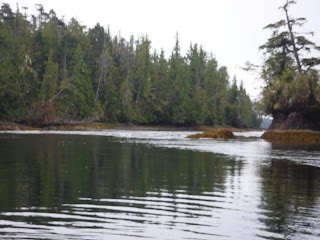We filled up our water jugs and did a bit of light laundry in the repugnant tidal estuary before setting out around 9:30.
 |
| The mouth of the northern Gale Passage rapids |
 |
| Contemplating the next move |
 |
| Paddling with the man in the mirror |
Out into Thompson Bay, we decided to check out the campsite at Cree Point and have a bite to eat. After a short paddle, we rounded the corner into a very protected little bay. Like at Dallas Island, the site was marked with a float. Behind a driftwood windbreak, there was one little-used tent site in a bed of soft moss, surrounded by salal.
We paddled down the shoreline of Potts Island to the Islet 48 site, which we'd heard spoken highly of. It had tons of "featurettes" including tropical sand,
a driftwood kitchen,
a pit toilet made of an old float,
and even a shower! Too bad it didn't have water in it, or we'd have taken advantage.
A sign said "Respect Heiltsuk territory", and another said "SIMON". The fire pit was stocked with kindling and ready to go. In the woods, a perfect tent site beckoned.
But it was only midday and we had miles to go, so we set out for McMullin instead. Swell was low and wind was light. An idyllic hour-long paddle brought us to the big sand beach on the west side of the big island.
The sand was the softest and finest I've ever seen — almost powdery! Our feet sank into it while unloading our boats. Mink tracks were the only sign of wildlife here.
A fine tent site is in the forest just up from the beach.
The high thin clouds were making eerie patterns across the sun. We both knew these clouds "meant" something when it came to weather prediction, but we couldn't remember what.
 |
| Sailor's delight? |
We didn't set an alarm for the morning.
September 6 dawned with heavy fog. I slept 11 hours, though the sleep was not an easy one. The ground felt hard underneath me and my dreams were full of gnawing things. As I staggered out to put a pot of coffee on, last night's raven feigned surprise and squawked over to a nearby islet. You could totally tell he was faking, though. There was no surprise or urgency in his voice. He then settled in making various quiet noises to himself. It really seemed to me that the sounds were not directed at another listener, that he was "talking to himself," as humans will do, albeit usually as an internal monologue.
We lit a fire and spent a quiet, meditative morning reading and watching the ravens. Their physical gestures change with the sounds they make; I can't tell whether the gestures are part of the communication, or part of how the raven has to arrange its body to make the particular sound. We ruminated for a while on krummholz — both in reality, because we'd seen so much of it out here, and as a metaphor for how the pressures of any environment shape your personality.
At one point the weather cleared enough to see Mount Buxton on Calvert Island in the distance. It didn't look too far. I tramped to the west side of the island with a baggie and collected as many salal and huckleberries as I could gather; I've never seen them grow so thick and plentifully.
We took a pre-dinner paddle through thick kelp beds to view the crossing to Goose and confirm the bearings we'd taken. There were otters galore out here — mothers carrying their babies, and teenagers playing rough with each other. They're devilishly hard to get a good photo of. Out in the sound we had brilliant views up and down the length of the coast from Swindle Island to Calvert. Inland views, too, with one really prominent peak in the distance — Tsil'os? The night had warmed up considerably. The water was beautiful: little swell and no wind.
I really needed this day: nowhere to go and nothing to do, and no objective — including not having "nothing" as an objective. My mind, still filled with the chatter of work and the city, quieted right down. Second day seeing no other human life: no boats, no planes. Sundown treated us to a show of brilliant phosphorescence at the water's edge, a coruscating display.















No comments:
Post a Comment